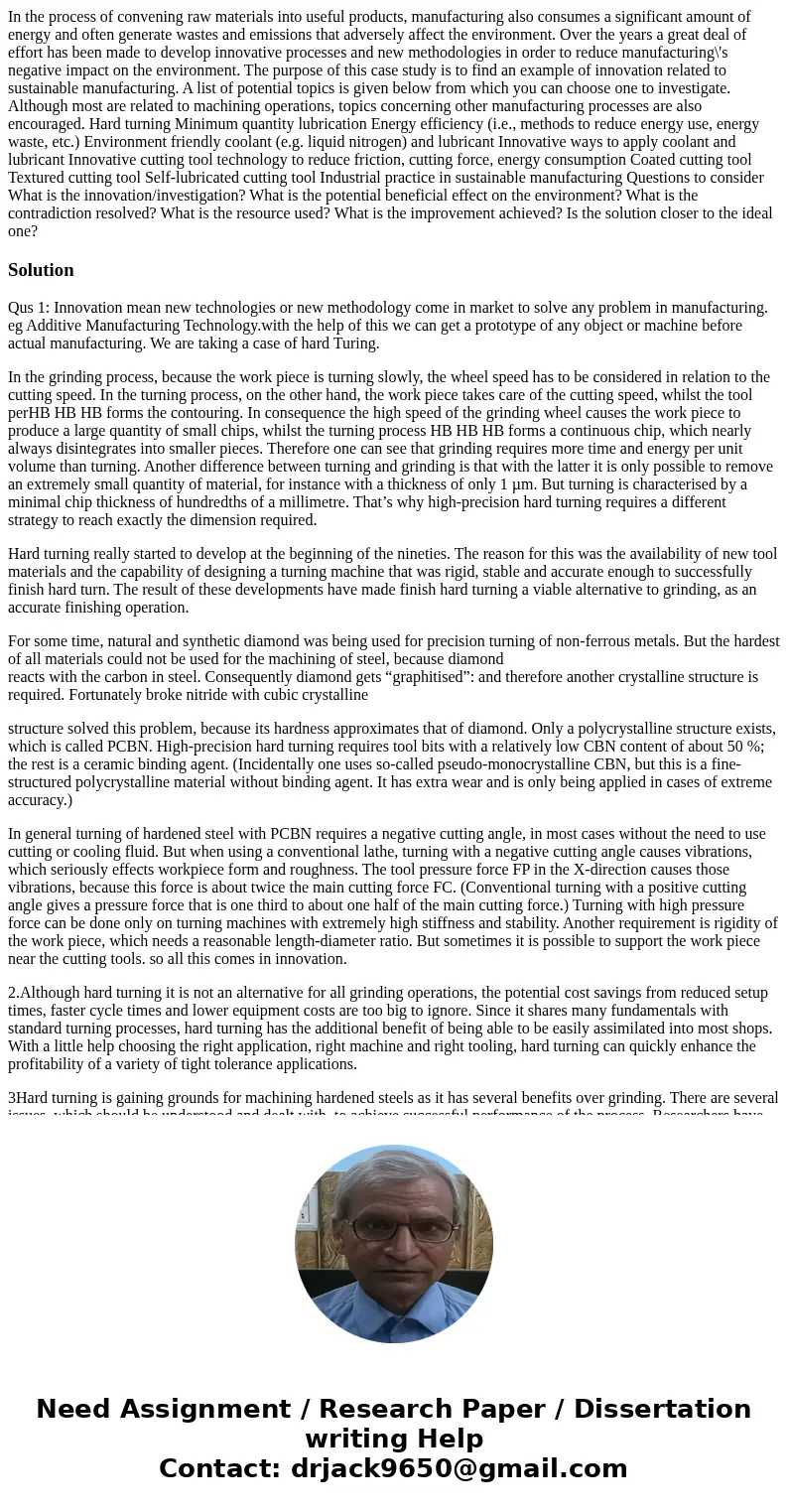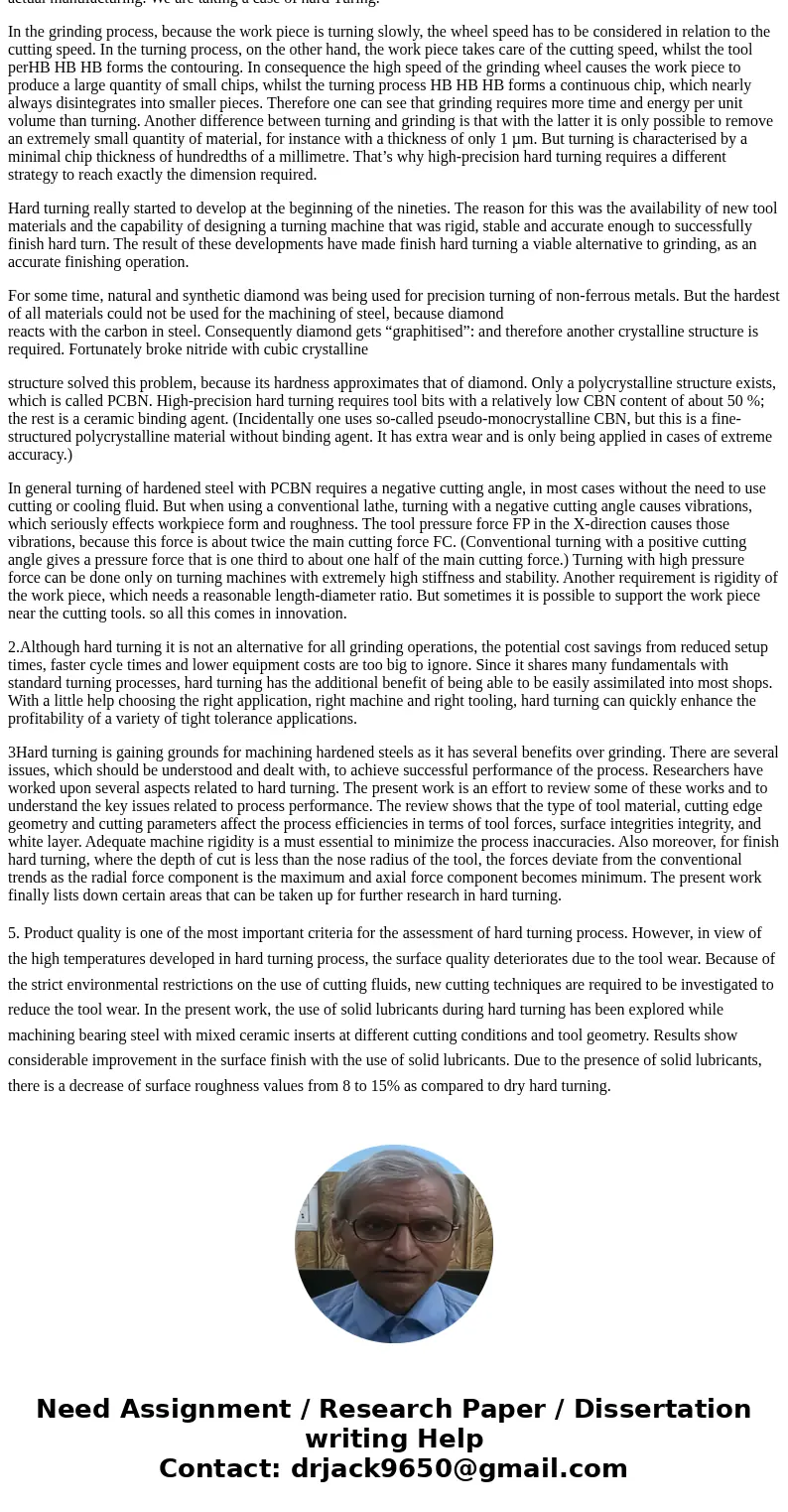In the process of convening raw materials into useful produc
Solution
Qus 1: Innovation mean new technologies or new methodology come in market to solve any problem in manufacturing. eg Additive Manufacturing Technology.with the help of this we can get a prototype of any object or machine before actual manufacturing. We are taking a case of hard Turing.
In the grinding process, because the work piece is turning slowly, the wheel speed has to be considered in relation to the cutting speed. In the turning process, on the other hand, the work piece takes care of the cutting speed, whilst the tool perHB HB HB forms the contouring. In consequence the high speed of the grinding wheel causes the work piece to produce a large quantity of small chips, whilst the turning process HB HB HB forms a continuous chip, which nearly always disintegrates into smaller pieces. Therefore one can see that grinding requires more time and energy per unit volume than turning. Another difference between turning and grinding is that with the latter it is only possible to remove an extremely small quantity of material, for instance with a thickness of only 1 µm. But turning is characterised by a minimal chip thickness of hundredths of a millimetre. That’s why high-precision hard turning requires a different strategy to reach exactly the dimension required.
Hard turning really started to develop at the beginning of the nineties. The reason for this was the availability of new tool materials and the capability of designing a turning machine that was rigid, stable and accurate enough to successfully finish hard turn. The result of these developments have made finish hard turning a viable alternative to grinding, as an accurate finishing operation.
For some time, natural and synthetic diamond was being used for precision turning of non-ferrous metals. But the hardest of all materials could not be used for the machining of steel, because diamond
reacts with the carbon in steel. Consequently diamond gets “graphitised”: and therefore another crystalline structure is required. Fortunately broke nitride with cubic crystalline
structure solved this problem, because its hardness approximates that of diamond. Only a polycrystalline structure exists, which is called PCBN. High-precision hard turning requires tool bits with a relatively low CBN content of about 50 %; the rest is a ceramic binding agent. (Incidentally one uses so-called pseudo-monocrystalline CBN, but this is a fine-structured polycrystalline material without binding agent. It has extra wear and is only being applied in cases of extreme accuracy.)
In general turning of hardened steel with PCBN requires a negative cutting angle, in most cases without the need to use cutting or cooling fluid. But when using a conventional lathe, turning with a negative cutting angle causes vibrations, which seriously effects workpiece form and roughness. The tool pressure force FP in the X-direction causes those vibrations, because this force is about twice the main cutting force FC. (Conventional turning with a positive cutting angle gives a pressure force that is one third to about one half of the main cutting force.) Turning with high pressure force can be done only on turning machines with extremely high stiffness and stability. Another requirement is rigidity of the work piece, which needs a reasonable length-diameter ratio. But sometimes it is possible to support the work piece near the cutting tools. so all this comes in innovation.
2.Although hard turning it is not an alternative for all grinding operations, the potential cost savings from reduced setup times, faster cycle times and lower equipment costs are too big to ignore. Since it shares many fundamentals with standard turning processes, hard turning has the additional benefit of being able to be easily assimilated into most shops. With a little help choosing the right application, right machine and right tooling, hard turning can quickly enhance the profitability of a variety of tight tolerance applications.
3Hard turning is gaining grounds for machining hardened steels as it has several benefits over grinding. There are several issues, which should be understood and dealt with, to achieve successful performance of the process. Researchers have worked upon several aspects related to hard turning. The present work is an effort to review some of these works and to understand the key issues related to process performance. The review shows that the type of tool material, cutting edge geometry and cutting parameters affect the process efficiencies in terms of tool forces, surface integrities integrity, and white layer. Adequate machine rigidity is a must essential to minimize the process inaccuracies. Also moreover, for finish hard turning, where the depth of cut is less than the nose radius of the tool, the forces deviate from the conventional trends as the radial force component is the maximum and axial force component becomes minimum. The present work finally lists down certain areas that can be taken up for further research in hard turning.
5. Product quality is one of the most important criteria for the assessment of hard turning process. However, in view of the high temperatures developed in hard turning process, the surface quality deteriorates due to the tool wear. Because of the strict environmental restrictions on the use of cutting fluids, new cutting techniques are required to be investigated to reduce the tool wear. In the present work, the use of solid lubricants during hard turning has been explored while machining bearing steel with mixed ceramic inserts at different cutting conditions and tool geometry. Results show considerable improvement in the surface finish with the use of solid lubricants. Due to the presence of solid lubricants, there is a decrease of surface roughness values from 8 to 15% as compared to dry hard turning.


 Homework Sourse
Homework Sourse